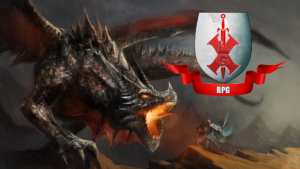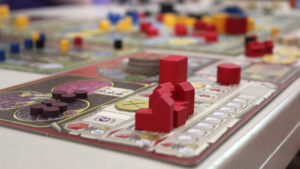A SHORT PERSONAL HISTORY OF GAMES and GAMING in BRISBANE
by Keith Done
This article outlines my own personal experiences with the tabletop gaming scene in Brisbane from
the 1960s to today. I encourage others to contribute similar articles and help fill in the gaps of areas I
haven’t really explored (such as miniatures). I will feature a different decade every two weeks.
Part 1 Vintage 1960s Games
I grew up with the curse of asthma and in the 1960’s there was nothing like ventolin to relieve the symptoms so I tended to spend a lot of times indoors. Naturally, I gravitated toward playing board games and became quite familiar with the old standards such as Monopoly and Scrabble. I spent many summer holidays bankrupting my friends of trying to grab triple letter scores using a Z.
I also came across Squatter during this time, which came across like an Australian version of Monopoly, whereby you established sheep stations and tries to amass herds of little plastic sheep. Squatter has been on and off the market for the past 40+ years and you can usually find a copy in department and specialty stores today when it’s in print. There’s a copy in the LXG library and I recommend you give it a go at a club meeting.
I did play a lot of other more common games such as Mouse Trap and Pow! But there were three titles that inflamed a passion in me for board gaming that continued beyond childhood. There was something unique about each one that I still find it hard to quantify. They weren’t very popular titles but they made an impression on me that lasted and I now find myself reminiscing about them and seeking copies of them on Ebay. These games were:
Combined Operations
This was an Australian made war game that was similar to Stratego but much better (in my opinion). It
had a basic map featuring two countries, with a sea dividing most of the territory but with a land area on
one side where ground forces engaged each other. A grid to regulate movement was printed on the board and the object was to capture one of two HQs your enemy had. To do this you had ground units, a navy and an air-force all of differing values, which were printed on cardboard rectangles slotted into plastic stands. Your forces were hidden from the eyes of your opponent and only revealed when playing pieces were next to each other on the board.
The game is superior to Stratego in that, instead of just the values of the pieces determining which units eliminate each other, certain types of units could only do damage to others. For example, there are different levels of ground troops, ranging from a Battalion (value 1) to an Army (value 5). Neither of these can eliminate an air-force piece. However anti-aircraft guns can shoot down all air-craft; bombers can eliminate all ground troops; naval destroyers can eliminate any ground unit in a coastal space (etc). There’s a printed matrix that tells you which unit beats another unit.
Combined Operations had three ‘sister games’ that featured only naval, air or ground elements. I’ve been able to find a copy of Combined Operations but not the others.
Railroader
 Railroader was a game produced by the UK Waddington company and involved rival companies building rail networks across the American western frontier in the 1880s. What amazed me when I was bought a copy in the 60s was the quality of the product. The huge board was lavishly illustrated and it included miniature trains and carriages plus plastic track sections (left, right and straight). The board had a grid of holes
Railroader was a game produced by the UK Waddington company and involved rival companies building rail networks across the American western frontier in the 1880s. What amazed me when I was bought a copy in the 60s was the quality of the product. The huge board was lavishly illustrated and it included miniature trains and carriages plus plastic track sections (left, right and straight). The board had a grid of holes
punched in it and you made money that allowed you to lay track and move your train. I don’t recall a lot of the rules but I do remember you could buy dynamite and destroy your opponent’s rails!
I recently won a copy of Railroader from Ebay and I’m eagerly awaiting its arrival from the UK. I’ll
bring it in to the club to play once it arrives.
Green Ghost

This is one I’ve tried to win on Ebay but I’ve always been beaten – which indicates the popularity of this
old favourite! Green Ghost was not a great strategy game by any means but it sure looked good to your average ten year old! The board was made of a plastic that glowed green in the dark and featured 3D haunted houses, graveyards etc. The board was elevated, allowing small cardboard pits to be fixed underneath. These were filled with little rubber snakes, bones and black feathers. You played the game in the dark and collected big plastic keys that allowed you to open the pits and reach in and grab little green ghosts – spooky! Once all the ghosts were collected by the players, they were all placed around the base of a huge ghost spinner; the big ghost got a spin and pointed to one of the little ghosts and, if it was one of yours, you were the winner.
Obviously an ardent board gamer today would condemn Green Ghost for its sheer randomness and I would agree! Despite that, I still have fond memories of the game and rate it highly for its sheer eye candy.
There were no organised board game clubs in Brisbane that I was aware of during the 60s and I played most games with friends from school. I remember during grades six and seven I became good friends with a person who was very interested in WWII history. We both shared a passion in collecting Airfix soldiers and making 1:72 scale model tanks and equipment. We ended up making up a set of very simple rules for having battles.
We would have turns at moving our armies – things like tanks could move the length of a school ruler; infantry half that distance. We would roll six sided dice and remove figures and model tanks according to pre-determined scores and hits required by weapon types. As for terrain – we used sheets with clothes bundled up underneath to make hills and cities made of stacks of books.

On reflection, this was not very different to what miniature war gaming evolved into and I can only think that, while we were playing our little battles, much older people were doing the same. However, some of those older people had the foresight to write down the games they played and go on to bring out early rule sets. Damn! The folly of youth – we missed out on making our fortune!
Next time: the 1970’s, where I discover real war games, I fathom the mystery of role-playing and
discover the first tabletop games club in Brisbane.


